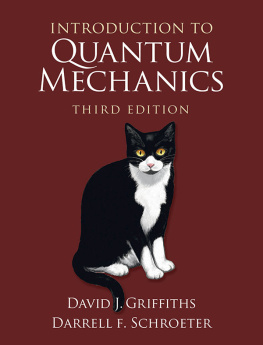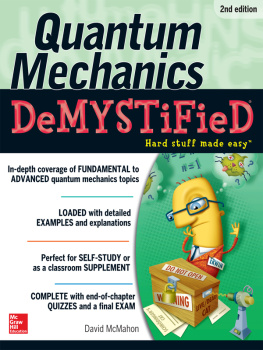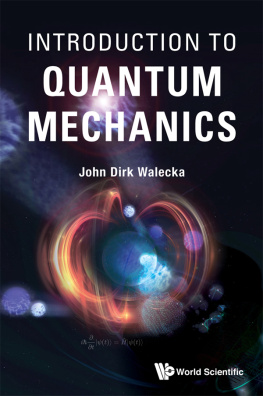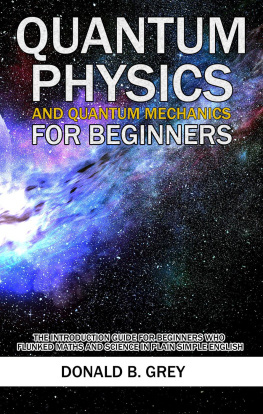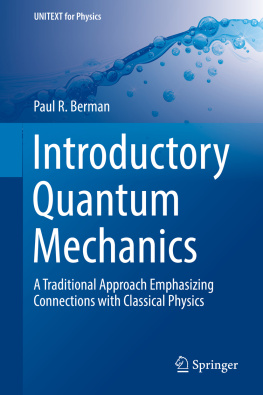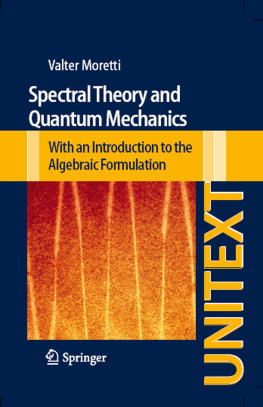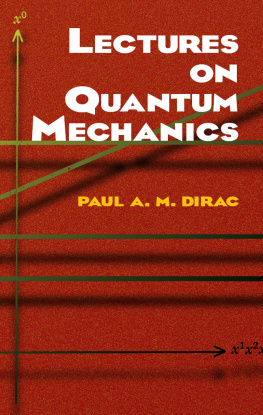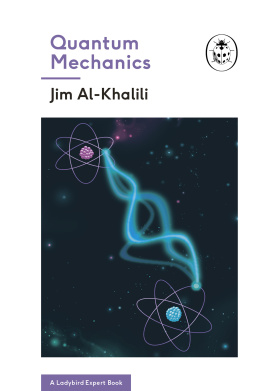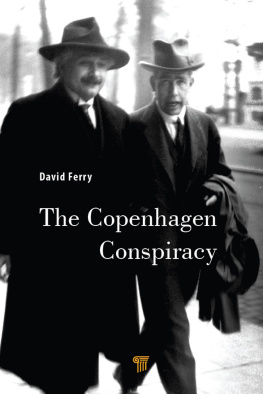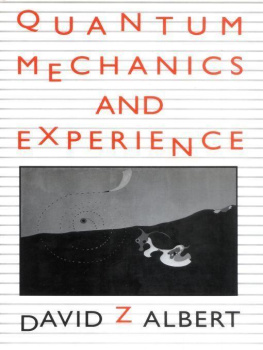David J. Griffiths - Introduction to Quantum Mechanics
Here you can read online David J. Griffiths - Introduction to Quantum Mechanics full text of the book (entire story) in english for free. Download pdf and epub, get meaning, cover and reviews about this ebook. year: 2018, publisher: Cambridge University Press, genre: Science. Description of the work, (preface) as well as reviews are available. Best literature library LitArk.com created for fans of good reading and offers a wide selection of genres:
Romance novel
Science fiction
Adventure
Detective
Science
History
Home and family
Prose
Art
Politics
Computer
Non-fiction
Religion
Business
Children
Humor
Choose a favorite category and find really read worthwhile books. Enjoy immersion in the world of imagination, feel the emotions of the characters or learn something new for yourself, make an fascinating discovery.
- Book:Introduction to Quantum Mechanics
- Author:
- Publisher:Cambridge University Press
- Genre:
- Year:2018
- Rating:4 / 5
- Favourites:Add to favourites
- Your mark:
- 80
- 1
- 2
- 3
- 4
- 5
Introduction to Quantum Mechanics: summary, description and annotation
We offer to read an annotation, description, summary or preface (depends on what the author of the book "Introduction to Quantum Mechanics" wrote himself). If you haven't found the necessary information about the book — write in the comments, we will try to find it.
Introduction to Quantum Mechanics — read online for free the complete book (whole text) full work
Below is the text of the book, divided by pages. System saving the place of the last page read, allows you to conveniently read the book "Introduction to Quantum Mechanics" online for free, without having to search again every time where you left off. Put a bookmark, and you can go to the page where you finished reading at any time.
Font size:
Interval:
Bookmark:
Introduction to Quantum Mechanics
Third edition
Changes and additions to the new edition of this classic textbook include:
- A new chapter on Symmetries and Conservation Laws
- New problems and examples
- Improved explanations
- More numerical problems to be worked on a computer
- New applications to solid state physics
- Consolidated treatment of time-dependent potentials
David J. Griffiths received his BA (1964) and PhD (1970) from Harvard University. He taught at Hampshire College, Mount Holyoke College, and Trinity College before joining the faculty at Reed College in 1978. In 20012002 he was visiting Professor of Physics at the Five Colleges (UMass, Amherst, Mount Holyoke, Smith, and Hampshire), and in the spring of 2007 he taught Electrodynamics at Stanford. Although his PhD was in elementary particle theory, most of his research is in electrodynamics and quantum mechanics. He is the author of over fifty articles and four books: Introduction to Electrodynamics (4th edition, Cambridge University Press, 2013), Introduction to Elementary Particles (2nd edition, Wiley-VCH, 2008), Introduction to Quantum Mechanics (2nd edition, Cambridge, 2005), and Revolutions in Twentieth-Century Physics (Cambridge, 2013).
Darrell F. Schroeter is a condensed matter theorist. He received his BA (1995) from Reed College and his PhD (2002) from Stanford University where he was a National Science Foundation Graduate Research Fellow. Before joining the Reed College faculty in 2007, Schroeter taught at both Swarthmore College and Occidental College. His record of successful theoretical research with undergraduate students was recognized in 2011 when he was named as a KITP-Anacapa scholar.
INTRODUCTION TO Quantum Mechanics
Third edition
DAVID J. GRIFFITHS and DARRELL F. SCHROETER
Reed College, Oregon


University Printing House, Cambridge CB2 8BS, United Kingdom
One Liberty Plaza, 20th Floor, New York, NY 10006, USA
477 Williamstown Road, Port Melbourne, VIC 3207, Australia
314321, 3rd Floor, Plot 3, Splendor Forum, Jasola District Centre, New Delhi 110025, India
79 Anson Road, #0604/06, Singapore 079906
Cambridge University Press is part of the University of Cambridge.
It furthers the Universitys mission by disseminating knowledge in the pursuit of education, learning, and research at the highest international levels of excellence.
www.cambridge.org
Information on this title: www.cambridge.org/9781107189638
DOI: 10.1017/9781316995433
Second edition David Griffiths 2017
Third edition Cambridge University Press 2018
This publication is in copyright. Subject to statutory exception and to the provisions of relevant collective licensing agreements, no reproduction of any part may take place without the written permission of Cambridge University Press.
This book was previously published by Pearson Education, Inc. 2004
Second edition reissued by Cambridge University Press 2017
Third edition 2018
Printed in the United Kingdom by TJ International Ltd. Padstow Cornwall, 2018
A catalogue record for this publication is available from the British Library.
Library of Congress Cataloging-in-Publication Data
Names: Griffiths, David J. | Schroeter, Darrell F.
Title: Introduction to quantum mechanics / David J. Griffiths (Reed College, Oregon), Darrell F. Schroeter (Reed College, Oregon).
Description: Third edition. | blah : Cambridge University Press, 2018.
Identifiers: LCCN 2018009864 | ISBN 9781107189638
Subjects: LCSH: Quantum theory.
Classification: LCC QC174.12 .G75 2018 | DDC 530.12dc23
LC record available at https://lccn.loc.gov/2018009864
ISBN 978-1-107-18963-8 Hardback
Additional resources for this publication at www.cambridge.org/IQM3ed
Cambridge University Press has no responsibility for the persistence or accuracy of URLs for external or third-party internet websites referred to in this publication and does not guarantee that any content on such websites is, or will remain, accurate or appropriate.
Unlike Newtons mechanics, or Maxwells electrodynamics, or Einsteins relativity, quantum theory was not createdor even definitively packagedby one individual, and it retains to this day some of the scars of its exhilarating but traumatic youth. There is no general consensus as to what its fundamental principles are, how it should be taught, or what it really means. Every competent physicist can do quantum mechanics, but the stories we tell ourselves about what we are doing are as various as the tales of Scheherazade, and almost as implausible. Niels Bohr said, If you are not confused by quantum physics then you havent really understood it; Richard Feynman remarked, I think I can safely say that nobody understands quantum mechanics.
The purpose of this book is to teach you how to do quantum mechanics. Apart from some essential background in Chapter .
Not only is quantum theory conceptually rich, it is also technically difficult, and exact solutions to all but the most artificial textbook examples are few and far between. It is therefore essential to develop special techniques for attacking more realistic problems. Accordingly, this book is divided into two parts; .
This book is intended for a one-semester or one-year course at the junior or senior level. A one-semester course will have to concentrate mainly on Part . The reader must be familiar with the rudiments of linear algebra (as summarized in the Appendix), complex numbers, and calculus up through partial derivatives; some acquaintance with Fourier analysis and the Dirac delta function would help. Elementary classical mechanics is essential, of course, and a little electrodynamics would be useful in places. As always, the more physics and math you know the easier it will be, and the more you will get out of your study. But quantum mechanics is not something that flows smoothly and naturally from earlier theories. On the contrary, it represents an abrupt and revolutionary departure from classical ideas, calling forth a wholly new and radically counterintuitive way of thinking about the world. That, indeed, is what makes it such a fascinating subject.
At first glance, this book may strike you as forbiddingly mathematical. We encounter Legendre, Hermite, and Laguerre polynomials, spherical harmonics, Bessel, Neumann, and Hankel functions, Airy functions, and even the Riemann zeta functionnot to mention Fourier transforms, Hilbert spaces, hermitian operators, and ClebschGordan coefficients. Is all this baggage really necessary? Perhaps not, but physics is like carpentry: Using the right tool makes the job easier, not more difficult, and teaching quantum mechanics without the appropriate mathematical equipment is like having a tooth extracted with a pair of pliersits possible, but painful. (On the other hand, it can be tedious and diverting if the instructor feels obliged to give elaborate lessons on the proper use of each tool. Our instinct is to hand the students shovels and tell them to start digging. They may develop blisters at first, but we still think this is the most efficient and exciting way to learn.) At any rate, we can assure you that there is no
Font size:
Interval:
Bookmark:
Similar books «Introduction to Quantum Mechanics»
Look at similar books to Introduction to Quantum Mechanics. We have selected literature similar in name and meaning in the hope of providing readers with more options to find new, interesting, not yet read works.
Discussion, reviews of the book Introduction to Quantum Mechanics and just readers' own opinions. Leave your comments, write what you think about the work, its meaning or the main characters. Specify what exactly you liked and what you didn't like, and why you think so.

